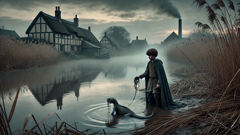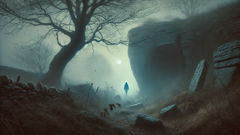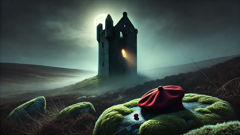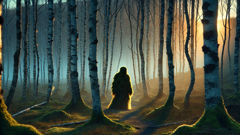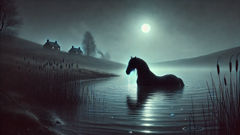Introduction
Windsor Forest breathes in slow centuries. Beneath a canopy of ancient oaks and leaning beeches, earth-scent and leaf-mold keep the map of human passing shallow; the older lines belong to deer and root. When mist lays like silk across the glades and the moon pricks holes in the low clouds, voices thin and the forest remembers. They say memory in Windsor chooses a shape, sometimes a hush, sometimes a footfall, sometimes a horned silhouette against froth of silver light. Herne the Hunter is that memory given body: a figure crowned with antlers, black as iron and old as myth, riding a horse that moves like the wind through the coppice. He appears where pathways thin and stories take root—by hollow oaks, by the river's bend, on the low rise that looks toward the castle. For many years Herne was a whisper among foresters, a proverb for children who stray too far; for others he was no more than the work of ale and moonlight. But across centuries his image hardens: the keeper who loved the forest turned specter who loves it still.
This tale does not pretend to be the single truth, and the wood will not be tamed by a single telling. There are many Herne stories—an old huntsman pinned high by a rope, a man who saved a king, a spirit of the stag, an omen, a guardian. Each version is like a leaf, different in vein but born of the same tree. In this retelling I stitch several leaves together: a long view of Windsor's oaks, the lives of men and women who worked those woods, the night Herne first took his antlers, and the nights since when the forest answers. Expect a story that moves between seasons and minds, between the human and the animal, and listen for the small sounds: a branch's sigh, a broken twig under a hoof, a faraway hound calling. These are the threads that keep a legend tethered to living soil, and as long as anyone walks the rides at dusk, Herne will have listeners.
Roots: The Making of a Legend
Windsor Forest has been shaped by kings and kine, by hunting and hearth, by treaties and timber. Men drew lines upon its map — rides cut straight for the chase, hedges clipped to mark dominion — yet beneath these lines another order persisted: the law of seasons, of rut and calving, of leaf-fall and blossom. In the Middle Ages, foresters were more than gamekeepers; they were the law's arm inside a sovereign's woodland. They patrolled the rides and rights, counted deer, and kept the delicate balance between household tables and wild herds. Herne, in many accounts, starts his story as one such keeper—a man keen-eyed, private, loyal beyond what men might expect. He knew every scent the forest could make and every fading path that led to spring-fed pools. He loved the place; the woods trusted him.

Legend says that in a winter of hard law and harder consequence, a hunt went wrong. The king was present, the hounds were eager, the chorus of horns was bright as brass, and a stag of remarkable antler broke for a hollow oak. A sudden fall, perhaps a misstep on a frost-slick root, left Herne grievously wounded—some say by a hunter's mistake, others by a jealous rival. In one telling, he died defending a royal honor; in another, he was accused unjustly and ruined. The most persistent detail holds: he returned to the forest changed. He was found impaled upon a tree, or perhaps he hung himself rather than endure shame. Where his head met the sky the bark grew blacker, and from his skull sprouted antlers as if some older law had taken him back into the game.
After his death, the tales split like roots. To some he became a cautionary shade. To others a guardian who prowled the rides, riding with the rhythm of horns and dog-breath. People woke to find their hounds unquiet, strays gone, and signs of great hooves in muddy rides where no horse had passed. Farmers whispered of cattle spooked at dusk, and huntsmen left bread and ale on favored stiles so the forest's keeper might pass in peace. Clergymen frowned and called these superstitions pagans reimagined; poets and children took him up with merriment and fear in equal measure. Herne's image grew antlers because the stag was the forest's nobility and the deer were the oldest residents; to crown a man with antlers is to say the forest has recollected him, that he belongs more to oak than to home.
It is important to note the medieval context. The law of forest was both practical and sacred: shifts in tenure, punishment for poaching, and the management of venison for the court. In a society where symbolic gestures carried weight, a story of a keeper transformed into a stag-headed specter delivered moral and political lessons in a language the rural world understood. It warned men who would steal against the king's eye. It comforted those whose livelihood depended on slow, seasonal trade. And, more quietly, it acknowledged a truth many felt: human claims on the wild are temporary. The forest keeps its own reckoning.
Yet the legend is not only about law. It is also about grief. If Herne was wronged—if he was betrayed, shamed, or sacrificed—the antlers become not merely a symbol of wild rulership but an emblem of sorrow worn openly. The stag's crown is a burden as much as it is a coronet; on moonless nights, the antlers gather frost like tears. People speak of rusted buckles and a voice that sounds from behind a bank of ferns—an attempt at a man's laugh threaded with wind. In the long run, grief and guardianship braid together in the figure of Herne; he is bound to the forest by ties that predate law and outlast mourning.
Through the centuries, Herne's story adapted. Tudor dramatists flirted with him as a source of eerie theatricality; antiquarians of later ages recorded the sightings as pieces of a vanishing rural past. Writers brought new angles—ritual, witchcraft, the Wild Hunt conflation—until the image became plural: sometimes cruel, sometimes kindly, rarely simply gone. Yet the center held: Herne is the forest's answer to human encroachment, a reminder that some debts are owed not to crown or court but to soil and sap. The makers of this tale listened for the old speech of oak and deer and found in Herne a voice that could speak it.
Between these larger strokes there are intimate encounters. An old forester named Aldred once claimed he watched Herne drive a line of deer out of a wheat-field one harvest eve, not as punishment but as a shepherding motion, herding them back to the rides. A widow who tended yards near the Great Park swore she saw a horse's eye like coal in the fog, and a pair of antlers pinned to a shadowed head. Children tell it differently: Herne is part bogeyman and part fairy god—he'll claim a lost lamb or fetch a runaway child home, depending on how the child behaved. The plurality of these accounts is not contradiction but proof: myths are living things. They accommodate the small and the great, the practical and the poetic.
This is the making of a legend—layered, contradictory, human in its cunning. Herne belongs to Windsor not because the king decreed it but because the woodkeepers, the women who knit near the hearth, the boys who watched the hunt, and the poets who wrote by candlelight took him in. They fed the tale with late-night talk and morning witness, with bread on stiles and ale poured under oaks. In that work the forest and the folk made one another. The antlers, the horse, the pale cheek of moonlight—these are the stitches. And when travelers come to the rides at dusk, they walk on a tapestry.
The Night He Rides: Encounters and Echoes
Stories gather around particular nights as barnacles gather round a stone. For Herne there are such nights: the first frost of autumn when the leaves are brittle as old vellum, the darkest nights close to Samhain when boundary-thin things cross over, and the warm hush of some lost spring when a buck's call seems too close for comfort. Those who claim to have met him often speak first of a sound that was not sound: a tread like the deep hush of the land, or the crackle of antlers among bare branches. Then a horse appears, sometimes shining black, sometimes white with moon-dust, often smaller than one expects and as large as record-keeping will bear. Herne himself rides with an economy of motion: he does not shout nor wave; he opens and closes the world around him.
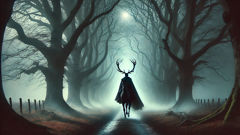
Take, for instance, the account of Thomas Meriweather, a gamekeeper in the later seventeenth century. Thomas was a precise man, practical to the point of stubbornness; he kept records of poachers and of births among the managed herds. One November evening he followed a track toward a stand of yew where he'd left his pipe. The air moved differently in that place—thick, slow—and the scent of the river turned to iron. He found the track of a great horse and then, in the hollow, a rider. The antlers were like a branched crown, slick with dew. Thomas's hounds drew near, hackles raised. The hounds did not leap or bay; they settled with a low whine. The rider turned to him and Thomas felt his face change, as if the rider's gaze recorded him and set the ledger right. Thomas later described the sound of the man's voice as 'a thing that can make cold and kindness the same,' and after that night he never again took a poacher's life for granted. The record itself is careful; Thomas signed his name the same as always, but the ink seemed frail afterward, as ink does when hands tremble with weather and wonder.
More recent accounts are equally striking but more modern in sensibility. In the nineteenth century a pair of Victorian antiquarians at Windsor recorded an old woman's tale: her son had been saved from drowning when a strange horseman spurred through the trees and led the child to a bank where rescue was possible. The woman baked bread for certain oaks afterward and called the act a debt repaid. These accounts do not cohere neatly; they resist tidy explanation. In them, Herne is sometimes savior, sometimes judge, sometimes conspicuous omen. He is not uniformly benevolent; travellers have also told of being hurried from the path, of being led toward hazards, of livestock found blooded at dawn. That contradictory nature is central: the forest's demands are not always human-friendly.
When modernity arrived, the story did not die away but shifted gears. Railway lines and estate planting altered shapes of rides. The roar of industry, for some, muted the old noises; for others, the change drew attention to what was lost. Early twentieth-century folklorists sought Herne as part of a catalog of older pagan survivals; they speculated about deer-gods and Green Men, about ritual kingship, about masks and horns. Yet the most potent recollections remain those lived by the people nearest to the rides: wives who set out a saucer of milk on a step for a passing spirit, boys who swore they'd seen the antlers break the skyline, keepers who kept their collars high. The tale proves adaptive because it answers a human need: to make the forest moral in a way our towns do not.
I tell one modern account at length not for proof but for texture. Elinor Finch is a young field ecologist who returns to Windsor when her father dies and leaves her a small cottage near the purples of the Great Park. She knows the science of trees—rings and cambium, soils and shrew—but life has hollowed her out in ways books cannot stock. One early March she sets out with notebook and thermos, intending to survey sapling regrowth on a ride where an old storm took a row of trees. The sky is a slow sheet of white; the ground smells like old bark and late rain. She loses the track of time. At dusk the weather shifts; mist gathers in a low bowl. She thinks she hears a deer call, a sound that plucks a low string inside her. Expecting a buck, she steps toward the ride's edge.
There is a presence—first the air shifting. Then a horse steps like a question from darkness. The rider is like a negative of the environment: a silhouette whose edges keep pulling at the fog. Elinor does not flee; some part of her, trained to catalog and listen, stays. He does not ride with malice. He is older than the people she has known, older than her grief, older than the saplings she counts. He lifts his head—antlers spread—and from him comes a low sound, half-hum, half-horn. Elinor reports later that the sound felt like being read aloud from a book she had not written. In her pocket is a scrap of paper—her father's handwriting noting the creek's eel population—but when she looks the ink has bled slightly, as if the night has moisture enough to alter what men document.
Herne, in that meeting, seems to compensate for a human absence. He guides Elinor's gaze to a sapling tilted against the wind, to a bed of new shoots promising a banked future. He does not speak in words she can carry to market but in directions: where to plant, where to leave water, where the badger paths promise good soil. She leaves bread at a stile the following morning, thinking: if silence is company for the dead, then reciprocity is a small defiance of loneliness. The next season the saplings flourish. Elinor keeps the story private for a time; she is not certain a scientist can profit from myth. Yet she returns each year to check the row of young oaks. The forest does its work, and Herne remains a part of its economy.
There is a politics to such encounters. For some, the idea of Herne evokes pagan rites, a reclaiming of untidy energies modernity prefers to house under glass. For others he is a reminder that histories of land tenure were messy and often cruel. In conservation circles his figure slides into the subtext of stewardship: the myth insists that land is not simply resource but relation. Those who ignore such relations do so at their peril; those who heed them find, sometimes, a companionable voice in the dark.
Whether Herne punishes or protects often depends on the walker's respect. That reciprocity lies at the heart of the legend. Leave the ride tidy, the stiles unblocked, the brooks clear; and the forest will return a temperate justice. Cut and conquer without care, and the shade of antlers will be less forgiving. In that old ledger—of bark and bone and rumor—the numbers add up. Men and women long ago learned to live with a myth that balanced its own books. He rides to keep that balance, and as long as anyone pauses to listen, the echo of his antlers will shape the night.
Conclusion
Legends survive because they answer questions we cannot ask otherwise. Herne the Hunter persists for reasons beyond his own story: he is a mirror held up to the wildness we have domesticated and a warning that domestication is never total. He offers a vocabulary for loss and an architecture for care; he is the antlered argument that some debts—those to land, to animal, to the slow work of seasons—cannot be settled with ledger alone. Walk the rides at dusk and you will feel the forest's patient attention, that careful, unremitting watch of root and leaf. If you are lucky, you might see a crown splitting the skyline, a horse stepping through the mist, and a figure whose face is both grief and guardianship. Whether you call him ghost, spirit, or the embodiment of old law, treat the sighting as you might a stranger in need: with respect, humility, and a willing heart. Windsor keeps its memories close. The oak remembers your tread; the stag will mark your passing. And Herne—if he rides that night—rides not merely to haunt but to remind us that we are guests in places that have been kept far longer than we have known how to keep them.


